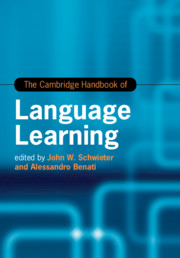Book contents
- The Cambridge Handbook of Language Learning
- Cambridge Handbooks in Language and Linguistics
- The Cambridge Handbook of Language Learning
- Copyright page
- Contents
- Figures
- Tables
- Contributors
- Acknowledgements
- Introduction
- Part I Theories
- Part II Methods
- Part III Skill Development
- 10 Interaction in L2 Learning
- 11 Speaking
- 12 Second Language Listening: Current Ideas, Current Issues
- 13 Contemporary Perspectives on L2 Upper-Register Text Processing
- 14 Language Learning Through Writing: Theoretical Perspectives and Empirical Evidence
- Part IV Individual Differences
- Part V Pedagogical Interventions and Approaches
- Part VI Context and Environment
- Part VII Moving Forward
- Index
- References
11 - Speaking
from Part III - Skill Development
Published online by Cambridge University Press: 25 June 2019
- The Cambridge Handbook of Language Learning
- Cambridge Handbooks in Language and Linguistics
- The Cambridge Handbook of Language Learning
- Copyright page
- Contents
- Figures
- Tables
- Contributors
- Acknowledgements
- Introduction
- Part I Theories
- Part II Methods
- Part III Skill Development
- 10 Interaction in L2 Learning
- 11 Speaking
- 12 Second Language Listening: Current Ideas, Current Issues
- 13 Contemporary Perspectives on L2 Upper-Register Text Processing
- 14 Language Learning Through Writing: Theoretical Perspectives and Empirical Evidence
- Part IV Individual Differences
- Part V Pedagogical Interventions and Approaches
- Part VI Context and Environment
- Part VII Moving Forward
- Index
- References
Summary
In describing the difficulties of establishing a definition for the construct second language (L2) “speaking”, Fulcher (2014) notes that “speaking is the verbal use of language to communicate with others” (p. 23). Such a broad definition is of course limited, as what enables successful spoken communication is variable. For example, Fulcher lists the following considerations: pronunciation and intonation; accuracy and fluency; strategies for speaking; structuring speech; speaking in context; and interactional competence. Such variability is evident when considering how high-stakes language assessments (e.g., the American Council on the Teaching of Foreign Languages (ACTFL), instruments based on the Common European Framework of Reference, International English Language Testing System (IELTS), Test of English as a Foreign Language (TOEFL)) define speaking within their frameworks. For example, whereas the IELTS speaking rubric includes categories for Fluency and Coherence, Lexical Resource, Grammatical Range and Accuracy, and Pronunciation, the TOEFL speaking rubrics emphasize General Description, Delivery, Language Use, and Topic Development.
- Type
- Chapter
- Information
- The Cambridge Handbook of Language Learning , pp. 258 - 282Publisher: Cambridge University PressPrint publication year: 2019



